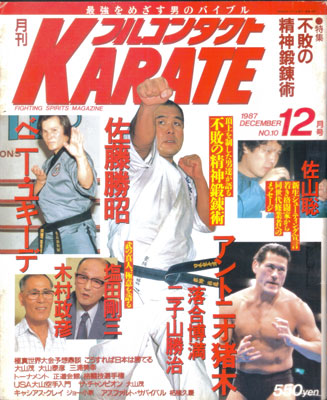 Full Contact Karate Magazine – December 1987
Full Contact Karate Magazine – December 1987
More Full Contact Karate at the Aikido Sangenkai! Previously we presented a translation of the article “Secret Technique: The Secret of Aiki” (秘技・合気の秘密) from the January 1996 issue of the Japanese magazine “Full Contact Karate” (フル・コンタクト・カラテ). This time we’re happy to present the English translation of an interview with Yoshinkan Aikido Founder Gozo Shioda (塩田剛三) and legendary Judo champion Masahiko Kimura (木村政彦) that appeared in the December 1987 issue of Full Contact Karate.
Gozo Shioda was born in Shinjuku, Tokyo in 1915. He began training with Aikido Founder Morihei Ueshiba O-Sensei in 1932 and trained under him for eight years before the war. After World War II he established Yoshinkan Aikido and became one of the major figures in the post-war Aikido world.
Masahiko Kimura was born in Kumamoto in 1917. At the age of 18 he became the youngest Judo 5th Dan in history, after defeating eight opponents in a row at Jigoro Kano’s Kodokan Dojo. It is said that he was defeated only four times in his professional career, one of those losses to Aikido student Kenshiro Abbe (although Abbe would not begin studying Aikido until some years later). He is most well known in the Western world for the famous match in 1949 in which he defeated Brazilian Jiu-Jitsu Founder Hélio Gracie.
Gozo Shioda and Masahiko Kimura were classmates at Takushoku University, which also counts such famous Karate instructors as Masatoshi Nakayama and Mas Oyama among its alumni.
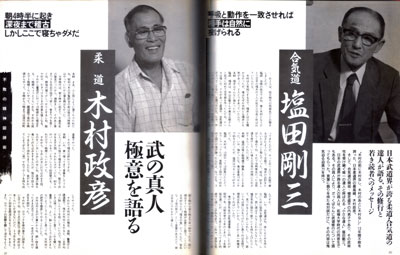 Masahiko Kimura and Gozo Shioda in Full Contact Karate Magazine
Masahiko Kimura and Gozo Shioda in Full Contact Karate Magazine
Interview with Gozo Shioda and Masahiko Kimura
(Full Contact Karate Magazine, December 1987 – translated by Christopher Li)
Interviewer: I’ve heard that you were classmates at Takudai (Takushoku University / 拓殖大学).
Shioda: In Takudai at that time I and Kimura and one other Karate practitioner, Fukui (福井功 / Isao Fukui), were called the “Three Crows” of Takudai (拓大三羽烏). (Translator’s Note: this is a common way of referring to three pre-eminent proponents of a certain skill) Kimura was shy and wouldn’t speak to Fukui, but for some reason I hit it off with both Kimura and Fukui and became friends with the two of them.
Kimura: Was Fukui that strong?
Shioda: Fukui started the Karate Club at Takudai along with Mr. Masatoshi Nakayama (中山正敏) and Mr. Masatomo Takagi (高木正朝). He was a strong fighter, but he had a strong personality and said that Judo or Aikido would be no problem for him. So I said that I would take him on, and the two of us did it in the gymnasium. He combined a right Seiken-zuki (“forefist punch” / 正拳突き) with a Mae-geri (“front kick” / 前蹴り), but I slipped right past him on the left, sandwiched his fist under my right forearm, and when I hit Fukui’s right elbow with my left forearm he just flew away. That guy’s elbow hurt for awhile, you know, and they took me in, just an unknown at the time who had been training in Aikido, as one of the Three Crows. (laughing)
Kimura: Shioda and I played at arm wrestling back then. Ahh, he was really strong. I was 170cm (5′ 6″) tall and 85 kg (187 lbs), and Shioda was 154 cm (5′) tall and 47 kg (103 lbs).
Shioda: Somewhere Kimura said that he lost ten out of ten times, but actually we did it three times and I only won the first two times. At most, he slipped his hand out the third time. (laughing)
Interviewer: Shioda sensei, were you doing some special kind of conditioning?
Shioda: No – in Aikido, in order not to create stagnation in the body, you mustn’t build up your muscles. However, I didn’t understand that when I was young, so I would hide from Ueshiba sensei and lift weights. When he found out I’d really get scolded. Of course it’s natural to want to make your body strong when you’re young, and logic comes later. Anyway, you should just train as much as you can. I trained everyday from five in the morning until nine at night! I think that kind of period is important to have when you’re young. Kimura over here was called the “Training Ogre” (稽古の鬼). There’s a famous phrase, “triple effort” (3倍の努力), but he really went through that.
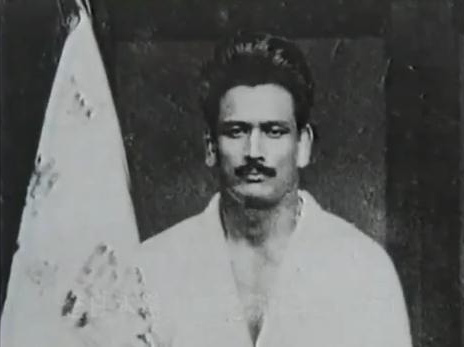 Masahiko Kimura’s Teacher – Tatsukuma Ushijima
Masahiko Kimura’s Teacher – Tatsukuma Ushijima
Kimura: Well, you can’t just lie around sleeping like everybody else. Before the Emperor’s Games (天覧試合) in Showa year 15 (1940) I didn’t even have time to sleep because I was practicing ten and a half hours every day. In my university days I would get up at 4:30 and clean, since I was one of the private students of Ushijima sensei (Translator’s Note: Tatsukuma Ushijima / 牛島辰熊, colloquially known as “Ogre Ushijima” and famous for his intense workouts), and then strike the makiwara from the left and right a thousand times each. You see, when you strike the makiwara you grip the thumb firmly, and when you strike the arms, elbows and wrists also become strong. Then I would go to the Police Department and train from around 10:00. For just about an hour. Then training at Takudai for about three hours, then at the Kodokan from 6:30 and from 8:00 to 11:00 at a local dojo in Fukagawa.
Interviewer: Was that the end of your training?
Kimura: No, after I went home and ate I would take a bath and then do solo training. First, a thousand push-ups, then body-building – six-hundred bench presses with 80 kg (175 lbs) barbells. Just that would take about an hour. Then uchikomi (打ち込み) against a maple tree a thousand times. I would wrap a Judo belt around a very thick maple tree and do uchikomi, but doing that a thousand times a day the trees would snap rather quickly. It was really expensive. (laughing) Then I would take out the rope and do Osoto Gari (大外刈) training. In those days, when I did Osoto Gari at the Police Department and the Kodokan, an average of ten people a day would get concussions, so I was told not to use it during training. When I heard that I worked it even harder, thinking that I didn’t want to be satisfied with just a concussion. I made a thorough study of Osoto Gari. Doing all this would last until around 2:30 at night. However, I couldn’t go to sleep right away. When human beings go to sleep it’s the same as if they’re dead. Even if everybody dies, I wanted to alive and training alone. I thought that this kind of training would help me to be victorious. I would pinch myself and practice keeping myself awake until around 4:30 in the morning. I would always take the first train of the morning and think “Ahh, the night is ending. There were many times when I didn’t sleep a wink. But I had a secret technique – I would sleep at school! (laughing)
Shioda: You were always sleeping in class. Kimura was in our class, so nobody failed. Because he’d kick our butts.
Kimura: When you don’t lie down in a futon to sleep the day’s training condition floats into your mind. Usually I’d train with around a hundred people a day, and each person would come out so that I could review the instant of applying each technique in stop motion. That way I would know whether each technique was good or not.
Shioda: Well, even if you tell young people today to train like that it’s just impossible. There is nobody comparable to Kimura in today’s Judo. Even if he did it today, people like (Yasuhiro) Yamashita and (Hitoshi) Saito would just be tumbled over. Even with just a single Osoto Gari, the execution was different. It wasn’t like today’s competition of physical power, Kimura threw with technique. No matter how big they were, they would be down on the mat in an instant.
Kimura: When I work with a large opponent I think that it is easier to throw them. That’s because Japanese guys who are over 100 kg (220 lbs) aren’t solid. Since they don’t train enough they just build up fat.
Interviewer: Kimura sensei, from your point of view don’t Yamashita and Saito train enough?
Kimura: Hmm, I just can’t believe that they’re doing serious research on a technical level. When you do Judo you develop a wide gait, so when you step forward with your left foot you can’t help opening up a little. Since this is no good I changed the way that I walk. I point my toes straight forward and slide forward. That’s why even normal walking became training in footwork. If you can’t concentrate your power in one point then it just becomes throwing with your upper body, that’s why today’s Judo can’t win against Sumo. Actually, the larger the opponent is the easier they are to destabilize. Because they have weight, if you destabilize them just slightly then their own body weight works against them.
Shioda: There is no destabilization (“kuzushi” / 崩し) in Judo today. It has become okay even if a small person cannot throw a large person.
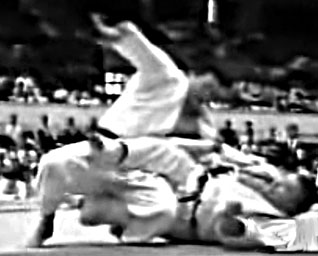 Sumio Endo downs Yasuhiro Yamashita with Kani Basami (蟹挟)
Sumio Endo downs Yasuhiro Yamashita with Kani Basami (蟹挟)
Kimura: Their way of seeing Judo is different. In our time, it was a Bujutsu that considered responses to an opponent that would punch or kick. In a game there is just winning and losing. When Yamashita fought with Endo, in that match Yamashita was clearly the loser. Just after the match began Endo threw Yamashita with Kani Basami, so why was it extended into a draw? Kani Basami is a prohibited technique, so it was a foul against Endo, but if it were OK then Endo would have won. The results of a match are something that follow you for the rest of your life, so for the victory or defeat of the athletes to be at the mercy of the rules of the organizers is ludicrous.
Shioda: Even if you talk about death, someone who hasn’t confronted death doesn’t understand how to be ready for it.
Kimura: A while ago the Chancellor of Takudai said “Kimura-san, you said that you would accomplish things even if you were dead, but if you died wouldn’t you lose everything?”. I thought that here was a person who had never thoroughly trained in Budo. What I want to say is, if you are truly resigned to death, then the level of your training is different.
Shioda: You can’t ask people to try and understand that intellectually. It’s easy to talk about staking your life on something, but when you get to the actual execution they can’t abandon their self.
Kimura: That’s right, the self really disappears. I thought about the meaning of death, about showing them that I would die if I lost the match, I placed a short sword on my desk. There was a time when I stabbed the short sword into my abdomen to see if I could really die or not. I thought, okay – if I just pull the sword now then it’ll be done. So first is the match, then I just have to pull it in one swift stroke. Then I was at ease – I had proven to myself that I would be able to die.
Shioda: True to your nature, the man called Masahiko Kimura is really something. If you go that far then there will be nothing that can frighten you. Takudai really produced an amazing man. There is no university other than Takudai that has ever produced a man like Kimura, who has reached to the heart of the martial arts. Takudai should feel more pride about that. Because all that Todai (Tokyo University) has is knowledge! (laughing) It’s not intellectual, if you don’t realize it by actually discarding your self and experiencing it then it will be impossible for you.
Kimura: Shioda, you have also experienced the edge of life and death many times. A lot of things happened back then, didn’t they?
Shioda: The edge of life and death…Well, it’s all in the past, so I guess that it’s alright to talk about it. Until that time, although I was training in Aikido, I didn’t know whether or not I was becoming strong, but when I left Japan Sensei said to me “Shioda – wherever you go you won’t lose”. Even so, I didn’t have much confidence, but there was an event that caused me to face death, and I feel that this was where I somehow learned to abandon the self. When I returned to Japan I went to teach at the Japanese National Police Academy, but I was never defeated, even once.
Kimura: Speaking of discarding one’s life, I had a mysterious experience in which I truly discarded my life. I went to train, and there were about 82 students there, all of whom had been undergoing strenuous training. They were strong back then. We’re talking about an instructor’s college. So I said “Yoroshiku Onegaishimasu” and stepped into the Dojo for Kakari Geiko (かかり稽古 / “continuous attack practice”). I had won the student championships, so when I threw one of them the next one would charge at me, and I’d try to hang on and go all out to throw him. I thought that even if I went to my knees I would get Ippon. I’d do about five minutes with one person, for around seventy people. At some point I began to feel faint, and when I braced myself against it I lost consciousness and fell forward. However, my body was moving. Even though I lost consciousness the offensive and defensive techniques kept on fighting for me. I don’t know where I went then. When I looked, about 15 students of the instructor’s college were gathered together looking at something in one corner of the Dojo. I wondered what they were doing while I was training, and when I glanced over I saw somebody stretched out on the floor. When I looked down from above I said “Hey, isn’t that me?”. (laughing) When I looked at my face stretched out on the floor it looked calm and peaceful. I was smiling as I slept. I felt that this was a really good way to sleep.
Shioda: I wonder which was reality?
Kimura: Well, as I was wondering which was real, and if I was here then who was it that had died, the training finished. Just before human beings die, before they go to the spirit world, maybe there’s something there.
Shioda: It’s a good thing that you didn’t die!
Kimura: Because it went on for seven hours. I never went to my knees, not once. I was in a haze, but everybody was shocked when I left humming a tune. (laughing)
Shioda: Like Kimura, I have seen the miracle of spirit, of inner strength as well. Sensei’s idea was that even if the body deteriorates one must strengthen the spirit, that’s why he said “I’ll be the strongest before I rise up to heaven”, and I have a story that demonstrates this. Sensei passed away from cancer, and in the days before he died he was reduced to skin and bones, but he suddenly jumped up from the futon and said “Let’s train!”. When the strong young uchi-deshi tried to stop him, because he had been restricted to complete bed rest, all four of them were thrown out into the garden. Kimura spoke before about fighting without consciousness, but this is also one of the secrets of Aikido.
Interviewer: Can you two masters teach us how a normal person can train so that they can approach this secret?
Kimura: Of course, you can’t do anything but train. But if you just tell people today to train it doesn’t work. Perhaps it’s that they don’t want to waste their time with useless training. However, it’s important to remember this – there are different levels in training. At first one just thinks to to become strong, but there’s no art in that. Once one reaches a certain level they wish to be seen as strong by the people around them. Because they want to show how strong they are they want to throw their opponents. But that’s no good. If you keep a clear hold on your purpose, on which techniques you want to master, then whether you are thrown by your opponent or whatever, it’s not relevant. Since I specialized in Osoto Gari, even if I lost I lost with Osoto Gari. By thinking to master that technique I kept my beginner’s mind.
Shioda: It’s the basics. Until you have mastered the basics it will be impossible for you to progress. When I was being taught by Ueshiba sensei, I never knew from day to day what I would be taught. One day would be extremely advanced, and the next would be basics. Now, as I stand in a position to teach Aikido, I have extracted just a few basics from my experience and try to have people master those thoroughly.
Kimura: When I was training alone it would be mostly the repetition of basics. However, once one reaches a certain point it shouldn’t just be the repetition of traditional forms, one must also understand the meaning contained within the movement. Where you throw the opponent, if you throw them here, when the direction of the throw changes the movements of your hands and the way that you drop your hips becomes completely different. That is because once you decide to throw them in a certain place then the movements of your hands, the position of your hips, the way that you close your armpits and the way that your hips enter becomes determined. People today do not research this, they just repeat the ancient forms the same way each time. There are tall people and there are short people. Depending on their height the technique changes. If one does not understand the principle then one cannot begin to research a technique that is appropriate for that person.
Shioda: If you infuse the techniques into your body thoroughly then after that techniques that are appropriate for an opponent come forth naturally. Kimura spoke about fighting while unconscious, but that is something that comes about after thoroughly infusing the techniques into the body. If one thinks about trying to throw them this or or that way it will never work. Perhaps an adept like Kimura can do it while unconscious, but in Aikido this is called Kokyu-ryoku. Power that is not power, power that comes forth and naturally matches to the opponent. You could call it a rhythm. There are three kinds of breathing – inhaling, exhaling, and holding your breath. The inhaling breath invites the opponent in, exhaling is the moment of greatest power, and holding one’s breath is the moment of instantaneous movement. One matches the centerline (中心線) to these three pulses. As long as the centerline from your head to the bottoms of your feet is not destabilized you will not be thrown by your opponent. If one thinks about applying a technique in a certain way the technique follows after the thought, so a gap can occur and there will be no connection to the breath. However, if the breath and the movement match then all one has to do is to match with the opponent. One becomes able to react in response to the opponent’s movement. Before you realize it the opponent’s body becomes destabilized and one is able to throw them. This is Shizentai (自然体 / “natural stance”). It must be because he has mastered Shizentai that Kimura was able to throw his opponents, no matter how large they were. When Kimura won the student championships he was in nothingness. The opponents moved as he wished them to – that is because Nature worked in his favor.
Kimura: I don’t know anything about Nature, but I knew from the day before the competition that I would win. I would sit in seiza on the day before and think about whether I would win or lose. The same as Zen – when I did that the image of myself winning would rise up to the surface. Then I would light a candle to the gods and buddhas and pray for victory, and on the next day every opponent would appear small to me and I would win, as I had seen the day before. The day before the competition I would allow myself to become anxious over desires of winning or losing. As Shioda said, it may be that I would rid myself of those desires and then approach things in Shizentai.
Shioda: Although the movements of Aikido and Judo may be different, the fundamentals are the same. Although there are many ways to climb a mountain, the peak is always the same.
Kimura: The only way to climb up is through training.
Shioda: When you are young one must throw everything into it. Whether it’s fighting spirit or brute strength it’s important to use it all up. There is time enough to think about secrets or Shizentai when one becomes older, when one is young they should charge ahead recklessly.
Kimura: I would like for young people to come forward to continue the traditions of Japan, the nation of Budo.
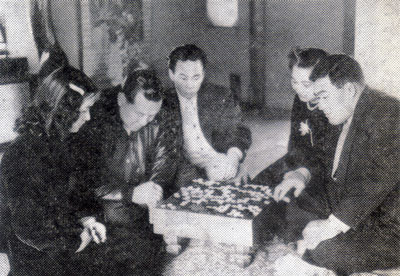 Kimura Masahiko with Kyokushinkai Karate Founder Mas Oyama
Kimura Masahiko with Kyokushinkai Karate Founder Mas Oyama
Published by: Christopher Li – Honolulu, HI
All of the content on this site is, and will continue to be, provided free of charge as a service to the community. You can help support this project by contributing a little bit to help support our efforts. Every donation (even $1) is greatly appreciated and helps to cover our server and bandwidth costs, and the time involved. The more support that we get the more interesting new content we can get out there!
By donating you also help support our efforts at Aikido Hawaii, which has provided a state-wide resource for all Aikido in Hawaii, regardless of style or affiliation, for almost twenty years.
Thank you for your support and encouragement,
Chris

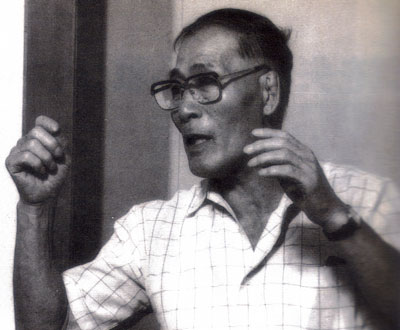
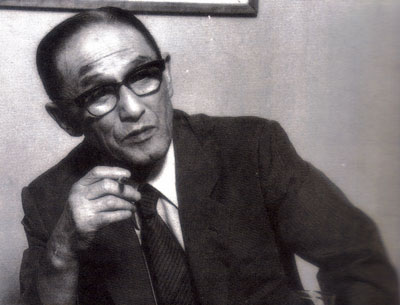
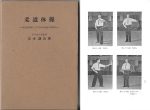


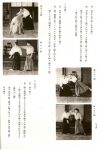
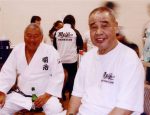
Thank you for once again providing your readership with stories, information and history that is of great value. As a 38 year student/practioner/instructor of Aikido, Aiki jui jitsu, Jui jitsu and Systema, I have found your newsletter to be an inspiration. I hope to one day support your efforts with more than words. Please keep up the great work.mm
Thanks Mark, I’m glad you’re enjoying the articles!
Best,
Chris
Sumio Endo breaks Yasuhiro Yamashita’s fibula with kani basami at 1980 All Japan judo championships.
OUCH!
That’s the one! Thanks Dan.
great article, thanks for the efforts
Thanks Mike!
Wonderful article. Thank you!
Thanks Joe!
Best,
Chris
nobody can do 600 bench presses with 85 kilos. Impossible feat.
Well, that’s what the article said – I suppose that you’d have to take it up with Kimura to be sure! 🙂
Best,
Chris
Someone here claims to have done a similar feat, but with varying weights… and not every day! http://www.pictame.com/user/bobbymaximus/187686466/1501114795058647674_187686466
It would probably be easier than becoming one of the greatest judo fighters of all time.
Looks pretty buff to me!
Best,
Chris
Hi there, can i translate this interview to portuguese? (with link to source, of course)
Hi Christiano,
Sure, feel free – just include a link back to the original article, and I’d appreciate it if you could send me a link to the translated version when you post it.
Best,
Chris
Great article, many thanks Christopher.
Do you know if Shioda has ever challenged Kimura?
(I think I would’ve bet on Shioda)
Glad you enjoyed it – outside of the arm wrestling in the interview, not that I know of – but I’m sure that would be an interesting story!
Best,
Chris
Dear Christopher LI! I always very enjoyed your web-site, your attitude to Aikido practice and your gripping articles. It is an astonishing and unselfish work. The great gift for all us! Thanks a lot!
But, please, don’t forget use “romanji” for an addition to any Japanese terms like here “…One matches the centerline (中心線)…”(quote)
Best regards,
Vasiliy (St.Petersburg, Russia)
“Chushin-sen”. 🙂 Glad you enjoyed it!
Best,
Chris
Thank you for posting this.